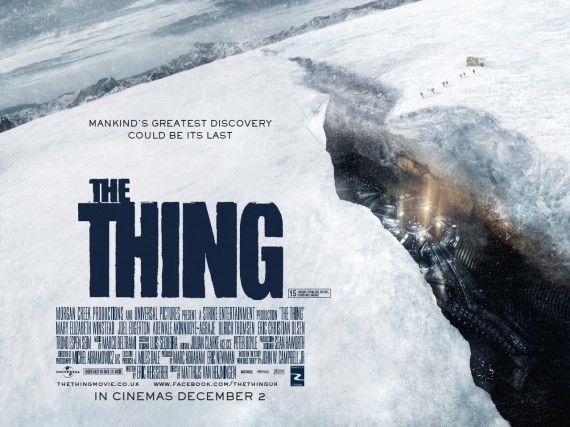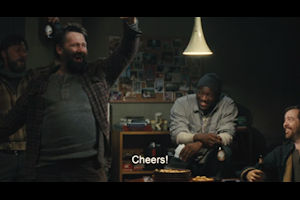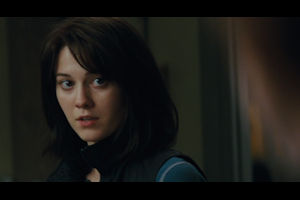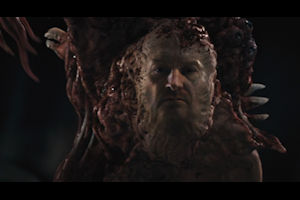The Thing (2011) - Movie Review
Welcome to THINGTOBER! A hostile alien has been revived in a remote Antarctic research station, and we have just one month to deal with it. Starting with John Campbell's classic novella "Who Goes There?" and then carefully dissecting the three films based on its ideas--The Thing from Another World, John Carpenter's The Thing, and 2011's The Thing--we will try to determine what makes this terrifying monster tick and whether or not we can ever be sure it's not right next to us, poised to take over the world.
 | | The UK poster |
It took roughly thirty years for John Carpenter to remake The Thing from Another World, and roughly another thirty years for a prequel to John Carpenter's The Thing to be released. Entitled simply The Thing, the most recent movie is set immediately before the events of the 1982 film and purports to tell the story of the Norwegian camp from which the titular Thing originated. It also has a lot of remake sensibilities, attempting to recapture the magic of the classic by copying certain scenes and plot beats. On paper, this isn't the worst idea to come out of Hollywood in the last ten years, but unfortunately, its execution only reinforces what makes the previous films good by completely failing to live up to them.
When I decided to rewatch 2011's The Thing for the purposes of this review, I allowed myself to hope that my recollection of my sole previous viewing was faulty, that maybe this remake/prequel isn't as bad as I remember. After all, people hated John Carpenter's original when it was first released, and it only gained a following years later. Maybe the 2011 version is the same. Maybe I was so blindsided by the terrible CGI (more on that later) that I missed a great movie hiding beneath. Alas, upon a second viewing, I can definitively say that 2011's The Thing is even worse than I remember.
Some critics enjoy lambasting movies, but I take no joy in what I have to do now. Apologies if you like this film, but I genuinely mourn its existence, because it's so painfully inept, so ruined by hacky writing, so scarred by dumb decisions going all the way back to conception, and so pale in comparison to its predecessors that it stands as a genuine Hollywood tragedy. In all seriousness and without hyperbole, this is one of those films that makes me feel sorry for everyone involved in creating it. I watch the credits and wonder if anyone listed is actually proud of what they've done.
 | | I wish all the characters were Lars |
With that out of the way, let's dive deep into what has gone wrong here, starting with the biggest single problem (even bigger than those visual effects): the script. In the previous films, the comraderie of the characters is an important element to consider. In The Thing from Another World, a sense of comraderie helps keep the tone light despite dark subject matter and works to elevate the sci-fi/horror campiness of the early 1950's. In John Carpenter's the Thing, an absence of comraderie helps accentuate the paranoia and distrust that makes the film so terrifying.
In 2011's The Thing, however, the story tries to have it both ways. The Norwegian crew is portrayed as very close and friendly, with characters that love to drink, sing, and tell bawdy jokes with one another. They even warmly embrace the newcomers, the Americans. At the same time, however, the men in charge, Dr. Halvorson (Ulrich Thomsen) and Edvard Volner (Trond Espen Seim), are cartoonishly dickish and combative toward our protagonist, Kate (Mary Elizabeth Winstead), for no apparent reason. As a result, the film never achieves the humanistic stylings of the 1951 film or the cold lack of empathy of the 1982 film. Instead, it becomes tonally muddled.
It also doesn't help that the characters are less developed all around. They don't have the unique flaws of John Carpenter's crew or the obvious idiosyncracies of Howard Hawks'. A handful are memorable, but most of them feel like little more than cannon fodder. The few characters that aren't completely forgettable are, for the most part, lesser versions of better characters from previous films. For example, the main human antagonist, Dr. Halvorson, is in many ways a copy of Dr. Carrington (from The Thing from Another World) while Carter (Joel Edgerton) is a half-baked combination of previous protagonists Captain Hendry and R.J. MacReady. It's telling that the most interesting, original, and entertaining character in the film, Lars, is the only one who doesn't speak English.
 | | Mary Elizabeth Winstead is great, but Kate is garbage |
But by far the worst character is this film's heroine, Kate. I mean no disrespect to actress Mary Elizabeth Winstead, whom I adore and crush over in other roles, but as written, Kate is the absolute laziest and most insufferable protagonist one can create: the flawless, omniscient know-it-all who figures out what's happening WAY too soon, is always right no matter what, and who becomes an unlikely leader despite everyone doubting her at every turn. On top of that, she is an American brought in through the loosest of excuses in order to placate American audiences. I'd call it whitewashing (or the "white savior" trope, to be more accurate) if it weren't for the fact that it's pretty hard to get whiter than a Norwegian. I contend that there was absolutely no need to have a single American in this movie, especially not in the role of better-than-everyone-else-at-everything protagonist. It's utterly asinine, and borderline offensive.
I know I'm harping on this point, but consider Hendry and MacReady, the protagonists from the previous films. Both are imperfect human beings who rise to the occasion despite their flaws. Hendry is quirky and awkward, but has military leadership skills that help pull the team together. MacReady is a tempermental, impatient alcoholic, but his abilities at chess point to the strategic know-how he uses to survive. Both characters rely on information provided by more intelligent characters, and both earn respect despite their problems of character. Kate, on the other hand, is a blank slate biologist with neither the human flaws to make her feel real nor the identifiable skills that could explain her almost superhuman powers of deduction and fighting prowess against the Thing. She's simply absurd.
And that's emblematic of one of the film's other primary flaws: it lacks subtlety. Every plot beat and character moment is telegraphed well in advance, overexplained, and bereft of both nuance and ambiguity. If you try to play the deductive reasoning game this time around, you'll finish after only a few minutes' thought, because every question has a definitive answer and no plot twist is open to multiple interpretations, assuming it even makes logical sense (which sometimes it doesn't). Even many of the underlying philosophical questions are undone in infuriating ways, such as the question of whether anybody could be a Thing and not know it. The dental fillings angle--which I'll grant is probably the cleverest idea in the whole script--makes it too easy for most of our characters to know definitively that they and most of their comrades are human.
 | | The Scorpion King wants his computer back |
All of this brutish plot execution also extends to the filmmaking itself. This is director Matthijs van Heijningen's only motion picture credit--with the rest of his portfolio being made up of beer, car, and Pepsi commercials--and it shows. The cinematography is uninspired, the editing is ham-fisted, and the pacing is all over the place. (I'll give the film a smidgen of credit for how well it lines things up with the 1982 film, but seeing as how that should be the baseline requirement for a decent prequel, I don't consider it high praise.)
And yes, the visual effects are horrendously bad. A talented crew from Amalgamated Dynamics, including the legendary Tom Woodruff, was hired to do the entire film using practical effects, and in the scenes where those practical effects are seen (such as the autopsy sequence), they are really quite good, almost as good as Rob Bottin's famous effects from the 1982 film. Unfortunately, thanks to a mixture of studio interference, last minute changes, and a perplexing enthusiasm for computer graphics, most of the practical work was literally erased in favor of exceptionally bad digital animation. (For more on the BTS story, I recommend this video essay by Georg Rockall-Schmidt.)
Try as I might, I can find nothing to recommend about 2011's The Thing, except to say that it highlights what makes the previous adaptations of "Who Goes There?" so much better. I will resist the obvious film critic joke about it being a poor imitation, but this is a truly bad film when you compare it to those previous classics. Maybe in 2041, after another thirty years have passed, we'll get another good version of the story, but until then, I think it's best we just pretend there have only been two movies called The Thing.
FINAL SCORE:





I can see this being a fun, guilty pleasure creature feature for those with low expectations and no familiarity with the source materials, but fans of the previous films and Campbell's original story should avoid 2011's prequel/remake like the plague upon humanity that it is.
|
[EDITOR'S NOTE: By popular demand, I am extending THINGTOBER for one more week. Come back after Halloween to check out my bonus review of Peter Watts' interesting short story reimagining of John Carpenter's The Thing, entitled "The Things."]
-e. magill 10/25/2018
THE UNAPOLOGETIC GEEK'S
THINGTOBER: | |
|
|
|